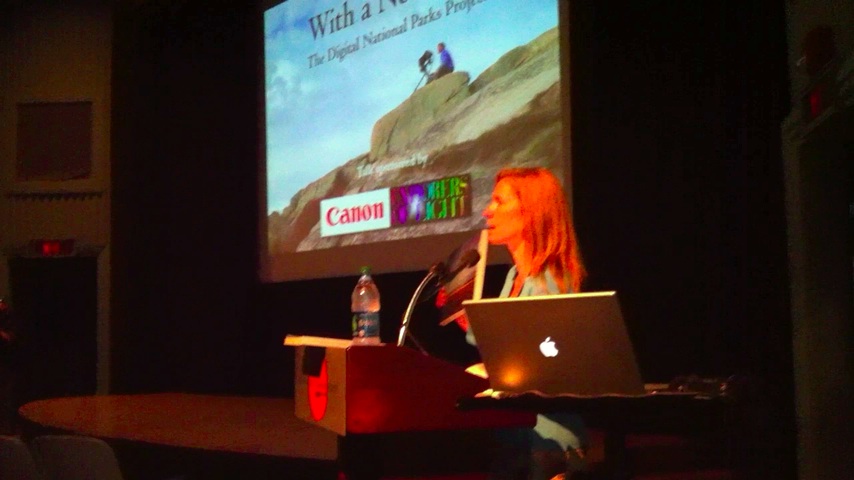 Steve Lecturing at the George Eastman House Museum of Photography. June 2012.
Steve Lecturing at the George Eastman House Museum of Photography. June 2012.
THE VIEW FROM HERE
by
Stephen Johnson
A Full Few Weeks of Travel, Teaching and Plunges into Photo Technology and History
I've been on a bit of a whirlwind these past few weeks and been anxious to sit down and write about some of the experiences. Hopefully writing about them will sort them out, as the memories are already starting to run together and form non-linear associations that have more to do with inspirations than linear story telling.
The first stop on my recent trip was an honor of a lifetime, lecturing at the George Eastman House Museum in Rochester NY. It was a real high to be coming into such a prestigious institution to talk about my national parks work "With a New Eye."
The Introduction to the talk by Eastman House Director of Communications Eliza Kozlowski can be found here. We'll be working on the video of the full talk.

QuickTime link of the Introduction to Steve's Lecture at the George Eastman House. June 2012.
We shipped in a few big prints which were shown briefly at a Welcoming Reception at the Image City Gallery, then in the foyer of the theater at the Eastman House. A season record breaker for attendance gave me quite a boost as so many old friends from Kodak came by to say hello. I believe the talk went well and we will be preparing a video from the footage, slide show stills and the audio made by the Eastman House.

Image City Gallery Reception. Rochester, NY. June 2012.
After Rochester and the Eastman House talk, we drove across New York state through southern Vermont and New Hampshire to our two weeks of classes at the Maine Media Workshops in Rockport.
Maine
My annual two weeks of classes for the Maine Media Workshops were yet another pleasure of people and place. The first week was a field work and editing class, the second a printing class. A few people stayed for both, which is ideal. Although teaching all day for two weeks straight is a challenge, the friends I make and the work I get to see and aid continues to be a wonderful spinoff of the classes.
The first evening of the class we (my partner Fiona, friend and fellow instructor Bobbi Lane, her assistant Lena, and my student Bill Filip) were invited out on the Appledore, a local 86 foot schooner, for a sunset cruise which started out the two weeks with a real Maine coast immersion. We happened to be the only clients that evening and got to not only enjoy the sea and sunset, but also got to steer a bit.

Fiona Sailing the Appledore. Camden Maine. 2012..

Vision and Craft: Perfecting the Photograph Class. Maine Media Workshops. 2012..
My lecture at the workshops this year was a slide show of my Exquisite Earth 1 show set to music, Fantasia on a Theme of Thomas Tallis by Vaughan Williams. Although I did a short introduction and follow-up, this was quite a departure for me, as I rarely just show the work. It was refreshing and curiously gave me a different perspective on this emerging body of work.

Printing Photographic Beauty Class. Maine Media Workshops. 2012. Reid Elem.
The Maine Media Workshops experience is always such a great mixture of disciplines, ages and projects all going on simultaneously that it continues to be a rich and rewarding part of my summer.
 |

Left: Steve getting to hold one of the Hasselblad cameras like Neil Armstrong used to take the photograph above of Buzz Aldrin at the Apollo 11 landing site. The same design was used on every lunar landing through the final flight of Apollo 17. |
Eastman House Archive
The art and technology collections of the Eastman House amazes me with every visit. This time we took the time to look at some of the historical processes collections, including some Daguerreotypes, ambrotypes and tintypes. Autochromes are always on my must see list as well and I saw my first 8x10 Autochrome on this trip. Many thanks to archivist Joe Struble for taking the time to show us so many beautiful pieces. I didn't know at the time that this experience would end up inspiring some work two weeks later in Maine.
There were a couple of special treats to this visit, Alfred Stieglitz's 8x10 Eastman View Camera given to the museum by Georgia O'Keefe (used for his Equivalences series and Georgia's Hands Portraits), Ansel Adam's first Brownie, and the specially designed Hasselblad 500EL made for the Apollo program and the moon landings.
The second week in Maine, my partner Fiona McDonnell (inspired by the collections we saw at the Eastman House) helped out with a Wet-Plate Collodian class and learned how to make tintype and wet-plate negatives from instructor Jill Enfield who ran a fine and inspiring class.

Birch Tree. Rockport Maine. Wet-plate Collodian Negative. Fiona McDonnell. 2012.
Fireworks and the 4th.

Like most of us, I love seeing fireworks, but once again this 4th of July, the scene I witnessed being out watching the fireworks was the photograph that stuck with me. It was the nearly full moon rising over the hills to the east of my studio with the broken clouds forming what seemed like a celestial nebula.
Tidbits
A few things I would like you to keep in mind...
We'll be going back to the eastern Sierra for a 7 day trek along its dramatic escarpment and into the White Mountains with their ancient Bristlecone pines. This is one of my favorite areas of California and allows me to link the high country of Yosemite to Mono Lake and the Owens Valley. The area is deeply embedded in my early years of landscape photography and often feels like a sojourn home.

White Mountains. 2011.












